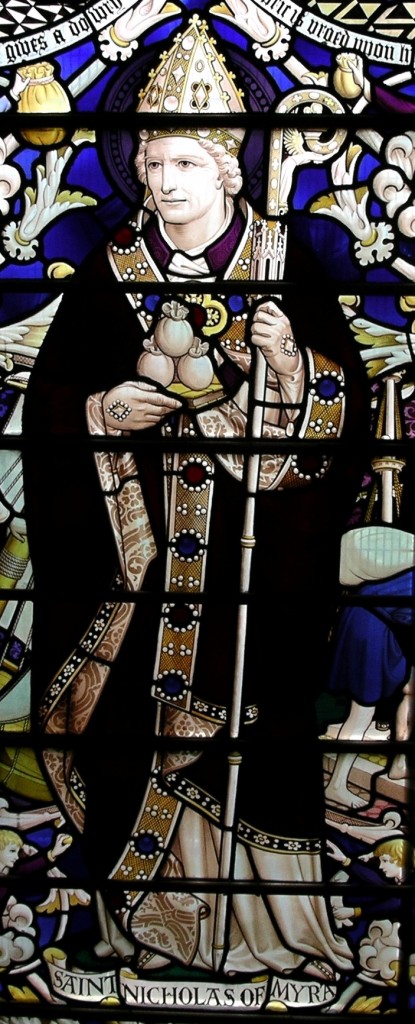The 6th December is celebrated as St Nicholas Day. He provides the theme of this post.
Who was St Nicholas? He was a real person but, as often happened with notable people in the past, it can be difficult to separate fact from fiction. Virtually the only thing that is certain about him is that he was Bishop of Myra (which is modern day Demre in SW Turkey) in the fourth century; but he became one of the most popular saints in both the Eastern and Western Churches. Tradition asserts that he was born, around 270, in Patara, another port not far distant from Myra. He probably died on 6th December 343 (or 352). The claim that his parents were wealthy but had died young and that an uncle, who brought him up and was Bishop of Patara is unlikely. Although it has been asserted that he was present as a champion of orthodoxy at the first Council of Nicea, called by the Roman Emperor, Constantine in 325, his name does not appear on any of the early lists of participants, making it very unlikely that he was one of the signatories of the Nicene Creed – still used in churches today.
Many other stories told of Nicholas are clearly legendary. However, it may be worth mentioning a few of them as together they may well give a true pointer to a man strongly committed to good and helpful actions. One story tells that Nicholas heard of a poor man who could not afford a dowry to allow his three daughters to marry. Secretly, at night, Nicholas delivered three purses of gold coins to them through the window. This story is depicted in one of the roundels in the window and lies behind the three gold disks to be found on the coat of arms of the Kirk – and the three ‘gold’ balls once commonly hanging outside pawnshops. He was also reputed to have performed a number of miracles including the raising to life three children who had been dismembered and pickled by a innkeeper. This is depicted on the reverse side of a 15th century .Burgh seal and also on roof boss above the desk in St Mary’s Chapel. The various stories lie behind the adoption of Nicholas as patron saint by varied groups of people – sailors, merchants, archers, repentant thieves, pawnbrokers and students, and, particularly, children. How this developed into the idea of Santa Claus is fairly obvious, the name coming via New Amsterdam (New York), from a Dutch version of his name.
After the removal in 1080 of his supposed relics from Myra to Bari in Italy the cult of Nicholas spread rapidly to many places, especially seaports. Accordingly, it is reasonable that the first church in Aberdeen, probably built soon after that date, should bear his name, but the first written record is dated 1157. He was regarded as patron not only of the Kirk but of the Burgh, and the records show that in the later middle ages the Rector of the Grammar School accompanied by one of his scholars dressed as bishop, visited the parents of pupils on St Nicholas’ Day to claim a contribution of four shillings Scots.

The photograph is of the central part of a window in the west wall of the West Kirk and features St Nicholas seen holding three money bags. The present building dates from 1755 but the window is the most recent there and was only installed, in 1927. The rest of the window, not shown, depicts other scenes from the life of St Nicholas and, in a corner, the sign of the artist, Geoffrey Webb – a spider’s web (Not visible in this photograph).
(The photograph is copyright Aberdeen Art Gallery & Museums Collections and is used with permission).